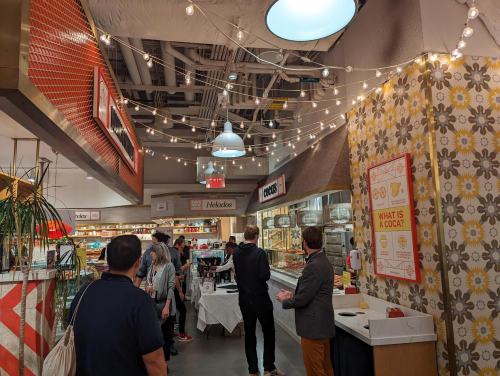Spanish gastronomic delights accented a breadth of wine offerings presented at the Eat & Drink Spain event in New York’s Mercado Little Spain, a market and dining concept by chef José Andrés, on October 17. Over 300 wines from across Spain were on display.
The wines showcased both the tradition of Spanish wines, as well as its evolution. On the traditional side were brands like Ole & Obrigado which presented wines from across the country using traditional winemaking methods. The labels of these wines similarly nodded toward the winemaker’s legacy, as well as the history of the region’s winemaking process.
Patrick Mata, co-owner of Ole Imports, shared that the company wants to educate consumers by offering wine at an accessible price point. One label featured an image of a donkey holding a basket of grapes, which is meant to communicate how the grapes arrive at the winery unbroken and in small batches, which helps to preserve the taste and flavor, he explained.
Many at the event shared innovations in wine. International trade marketing specialist at Codorniù, Jose Osuna, explained that the company is particularly proud of its nonalcoholic offerings of wines and sparkling wines, even offering a Brut, low-sugar wine variety that contains less than or equal to 15 grams of sugar per liter. He added that the beverage goes through a dealcoholizing process wherein alcohol is evaporated from the wine.
There is an emphasis on nonalcoholic, particularly in the U.S., that creates a lot of opportunity, he shared.
Both old and new wines offered many sustainability pledges. For example, companies showcased labels highlighting carbon neutrality “from grape to glass.” Biodynamic and organic wines were also a central topic of the event titled, “The Keys to Rioja: Quality, Diversity, & Commitment.”
In the Rioja region , there are 61 vineyards that are certified organic, and two are biodynamic certified, said host and master of wine Peter Marks. He added that the number of vineyards that follow these practices, however, is far greater, they just go uncertified.
He also explained that climate change and resilience are important factors to winemaking as it inspires makers to test new, and sometimes go back to traditional, tested grape varietals. For example, people are leveraging the resilience of the Garnacha red grape variety because of its particular growing conditions.
“Today’s wine in Rioja is not only revolutionary, it's evolutionary,” said Marks when explaining how the area’s Rioja region is constantly expanding and innovating.
In addition to wines, the event showcased jamón, Spanish cured ham, in addition to cheese and olive oil. Artequeso, a company that distributes in the U.S. with Baldor Specialty Foods was one of the companies on display, presenting three of its Manchego cheese offerings at various stages of aging.
In a dedicated section for Spanish companies seeking importers, distributors, and buyers, a company called Terrier presented its extra virgin olive oil. Already distributing throughout Europe and the United Arab Emirates, Xisco Blas shared that they are eager to expand to a U.S. audience.
Blas noted that American buyers already purchase their premium products on their website and see a lot of repeat purchases. Although he shared the difficult journey ahead for the brand to expand in a new market, he is encouraged by the fact the U.S. values high-quality products and a company with a rich, strong company story.
“At Treurer we show you how we achieve the highest quality [olive oil],” he said, explaining that the farm regularly invites people to tour its facilities and understand the company’s oil-making processes.
Related: Wegmans Debuts Manhattan Store; Sweetgreen Partners with Bari Olive Oil for EVOO

